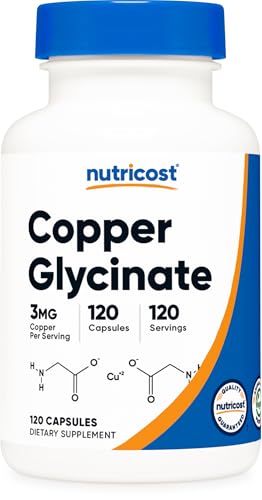Copper
Minerals
Overview
- Copper (Cu) is an essential trace mineral.
- It serves as a catalytic co-factor for over 30 enzymes.
- These enzymes are involved in:
- Energy production
- Antioxidant defense
- Connective-tissue formation
- In physiological concentrations, copper supports:
- Redox balance
- Iron metabolism
- Neuronal signaling
- It is indispensable for:
- Normal growth
- Immune competence
- Metabolic homeostasis
Benefits
- Energy metabolism: Cu-dependent cytochrome c oxidase drives mitochondrial ATP synthesis, supporting endurance and muscle performance.
- Antioxidant protection: As a component of superoxide dismutase (SOD1), copper mitigates oxidative stress, which may lower the risk of cardiovascular disease and neurodegeneration.
- Neuro-cognitive health: Adequate copper supports myelination and neurotransmitter synthesis (e.g., dopamine, norepinephrine); low status has been linked to impaired cognition and mood disturbances.
- Iron homeostasis: Copper-dependent ceruloplasmin oxidizes Fe²⁺ to Fe³⁺ for transport, preventing anemia and supporting erythropoiesis.
- Connective-tissue integrity: Lysyl oxidase, a copper-dependent enzyme, cross-links collagen and elastin, supporting skin, bone, and wound healing.
- Immune function: Copper modulates neutrophil activity and supports antimicrobial peptide expression, contributing to innate immunity.
How It Works
- Copper functions primarily as a redox-active metal ion (Cu⁺/Cu²⁺) that cycles between oxidation states to facilitate electron transfer.
- In mitochondria:
- Cu⁺ binds to the catalytic core of cytochrome c oxidase (Complex IV).
- This enables the final electron transfer to oxygen and proton pumping for ATP generation.
- In the cytosol:
- Copper serves as a co-factor for Cu/Zn-SOD.
- It catalyzes dismutation of superoxide radicals into H₂O₂ and O₂, limiting oxidative damage.
- Copper-dependent enzymes like ceruloplasmin oxidize Fe²⁺ to Fe³⁺, facilitating ferroportin-mediated iron export.
- In the nervous system, copper is required for dopamine β-hydroxylase, converting dopamine to norepinephrine.
- The metal is delivered to target enzymes by copper chaperones (e.g., Atox1, CCS), preventing free-ion toxicity.
- These pathways collectively support energy, antioxidant, and neurotransmitter processes.
Dosage
- The Recommended Dietary Allowance (RDA) for adults is 0.9 mg day⁻¹ (≈13 µmol).
- The Upper Intake Level (UL) for adults is 10 mg day⁻¹.
- Supplementation typically uses 2–5 mg elemental copper per day.
- Common forms of copper supplements include:
- Copper gluconate
- Copper sulfate
- Copper bisglycinate
- For athletes or individuals with documented deficiency:
- 1–2 mg elemental copper per day for 6–12 weeks can restore tissue stores.
- Followed by a maintenance dose of 0.5–1 mg/day.
- To improve absorption, take with a meal containing protein.
- Avoid simultaneous high-dose zinc (>30 mg) as it can impair copper absorption.
- Pregnant and lactating women may require up to 1.3 mg/day (RDA 1.3 mg).
- Chronic supplementation above the UL should be avoided due to the risk of toxicity.
Safety & Side Effects
- Copper is generally safe at RDA and modest supplemental doses.
- Adverse effects of excess intake (>10 mg/day) include:
- Gastrointestinal upset (nausea, vomiting)
- Metallic taste
- At chronic high doses:
- Hepatic injury
- Neurotoxicity (tremor, ataxia)
- Wilson-like copper accumulation
- Contraindications include:
- Wilson’s disease (defective copper excretion)
- Hemochromatosis (excess iron can exacerbate copper toxicity)
- Severe renal impairment
- Significant drug interactions:
- High-dose zinc supplements (≥50 mg) reduce copper absorption.
- Penicillamine and trientine chelate copper, reducing efficacy.
- Oral contraceptives may increase copper levels.
- Children under 12 yr should not exceed 0.6 mg/day.
- Monitoring serum ceruloplasmin or copper-to-zinc ratios can guide safe use.
Chemistry
- Copper is a transition metal with atomic number 29 and electron configuration [Ar] 3d¹⁰ 4s¹.
- Its elemental form is Cu⁰, but biologically active species are Cu⁺ (cuprous) and Cu²⁺ (cupric).
- In supplements, copper is usually present as a salt (e.g., CuSO₄·5H₂O, CuC₆H₁₁O₇·H₂O) or chelate (e.g., Cu-bisglycinate).
- The IUPAC name for copper(II) ion is “copper(II)”.
- Copper has a high electrical conductivity (5.96 × 10⁷ S m⁻¹) and a melting point of 1085 °C.
- Its standard oxidation potentials (Cu²⁺/Cu⁺ = +0.16 V; Cu⁺/Cu⁰ = +0.52 V) enable its role as an electron carrier.
- Copper forms coordination complexes with nitrogen, sulfur, and oxygen ligands, essential for enzyme binding.
Sources & Quality
- Commercial copper is obtained primarily from the sulfide ore chalcopyrite (CuFeS₂) or oxide deposits (e.g., malachite Cu₂CO₃(OH)₂).
- Mining is followed by pyrometallurgical smelting, producing copper metal.
- Copper metal is subsequently refined by electro-refining to >99.99 % purity.
- For supplements, copper is typically obtained as:
- High-purity copper sulfate (derived from sulfuric acid leaching of ore)
- Through aqueous reaction of copper metal with organic acids (e.g., gluconic acid) to form copper gluconate.
- Chelated forms (copper bisglycinate) are produced by reacting copper salts with amino-acid ligands under controlled pH.
- Quality considerations include:
- Residual heavy metals
- Sulfate content
- Bio-availability
- Good Manufacturing Practice (GMP) certification and third-party testing (e.g., USP, NSF) ensure:
- Consistent elemental copper content
- Low contaminants
Where to Buy Copper






Affiliate Disclosure: We earn a commission if you purchase through these links at no additional cost to you. This helps us maintain our research and provides you with the best supplement information.